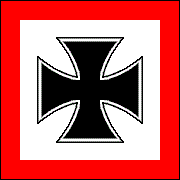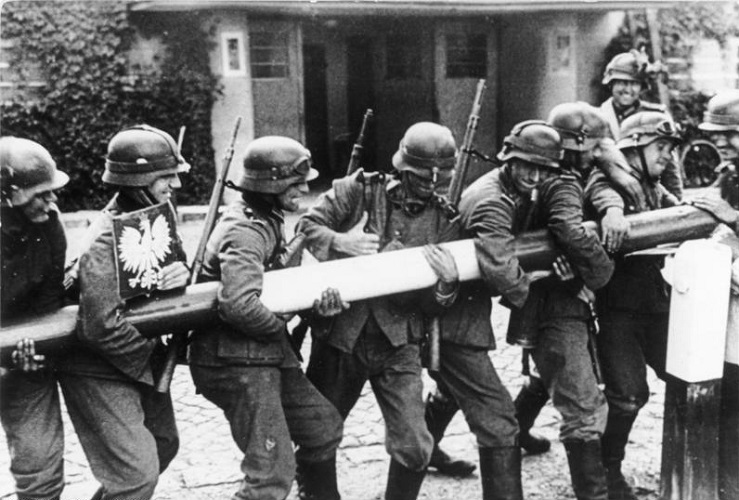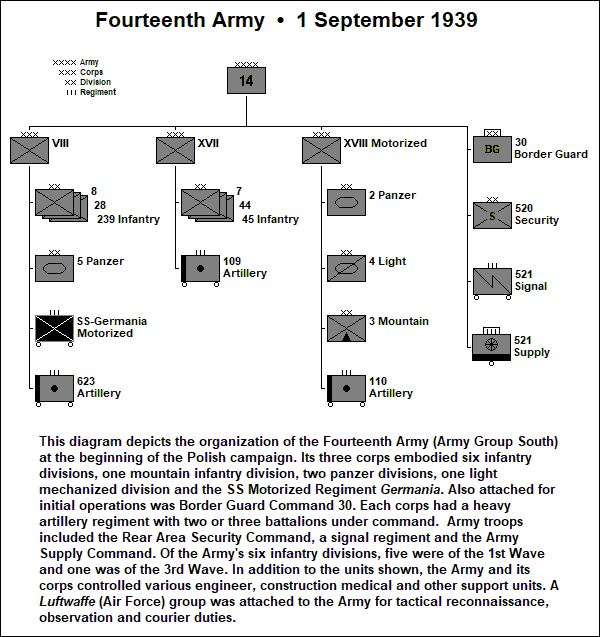In the late summer of 1939, with war
in sight, the German Army’s senior commanders were in no
confident mood, the Oberkommando des Heeres (OKH or
High Command of the Army) being all too well aware of the
Army’s deficiencies. To be sure, the crash rearmament
program embarked upon in 1935 had greatly increased the
Army’s size. In 1933 the
Reichwehr,
as the Army was then titled, had just seven infantry
divisions and three cavalry divisions. Now there were 85 infantry divisions, three mountain infantry
divisions, four motorized infantry divisions, seven panzer
(armored) divisions and four light mechanized divisions,
plus various brigades and independent regiments.
But of the 85
infantry
divisions, only those of
the 1st Wave, thirty-five in number, were substantially up
to strength. The other 50—those of the 2nd, 3rd and 4th
Waves—lacked many items of equipment. None had any 50mm or
81mm mortars, 20mm antiaircraft guns or 150mm heavy infantry
guns. The divisional artillery regiments were mostly
equipped with older or captured Czech weapons. In partial
compensation for these deficiencies the 3rd Wave divisions
did receive a higher allotment of machine guns but they too
were often older or captured models. Due to a shortage of
motor vehicles, the motorized elements of many infantry
divisions were actually horse drawn.
As for manpower, the 1919 Peace
Treaty’s prohibition of conscription had, as intended,
prevented the buildup of fully trained military reserves.
The 51 divisions of the 1st and 2nd Waves had the
highest percentages of active soldiers and Class I
Reservists, the latter being conscripts who’d served with
the colors for one or two years after conscription was
restarted in 1935. These divisions were considered fully
trained and fit for active service but even so many of them
were short of technical specialists and trained staff
officers.
The twenty divisions of the 3rd
Wave were the peacetime army’s Landwehr
(militia) divisions. Their personnel were older men, many of
them First World War veterans. Upon mobilization the
Landwehr divisions
were filled out with Class II Reservists. These men, born
between 1901 and 1913, were too young to have served in the
First World War, nor had they received any military training
in the Weimar years. Beginning in 1935 they’d been called up
for two or three months of basic military training—the bare
minimum. The fourteen divisions of the 4th Wave were set up
in early 1939. They also consisted mostly of
Landwehr men and Class
II reservists. To compensate for their lower state of
training the 3rd and 4th Waves divisions were given a
simplified organization and OKH planned to use them
mainly for static defense in quiet sectors.

Command flag, Oberbefehlshaber des
Heeres (Commander-in-Chief of the Army)
As for the mobile forces—the
panzer divisions, light mechanized divisions and
motorized infantry
divisions—they too were beset by various equipment and
manpower deficiencies. Many of the available tanks were
Panzer Is, originally intended for training and armed only
with machine guns, and Panzer IIs, armed with a 20mm gun.
The two models intended to be the panzer divisions’
mainstays, the Panzer III (37mm gun) and the Panzer IV (75mm
gun) were, due to production bottlenecks, in very short
supply. Former Czech Army tanks—of sound design, armed with
a 37mm gun—were therefore pressed into service. The panzer
divisions’ motorized infantry regiments were supposed to be
equipped with armored halftracks, but scarcely any were
available and trucks were substituted. However, since,
industry was unable to produce sufficient trucks to meet the
Army’s needs, many civilian trucks had to be requisitioned.
The mechanized divisions were also short of various
specialized armored vehicles: command tanks, armored command
cars, armored radio cars, etc.
The four light mechanized divisions
had been conceived as the mechanized successors to horse
cavalry formations. However, peacetime maneuvers revealed
that with just one battalion of tanks they lacked hitting
power. Plans were accordingly drawn up for their conversion
to full-fledged panzer divisions, but this could not be
completed before war broke out.
OKH judged that in the event of war
it would be necessary to commit all the mechanized divisions and
the bulk of the infantry divisions against Poland. Only
24 infantry divisions were allotted to
HG C, defending Germany’s western frontier. Clearly, so
meager a force could do little more than delay the prompt
French offensive that OKH expected—though its anxieties on
that score were somewhat eased by the Nazi-Soviet Pact,
which foreclosed the possibility of Red Army intervention in
support of the Poles. It was hoped that the Polish campaign
could be concluded quickly, so that forces could be released
for HG C before the French Army opened its offensive.
The mobilized German Army was
disposed in three army groups: HG C in the west,
HG Nord (North)
and HG Süd (South) against Poland. Each army group commanded a
number of field armies and each field army commanded a
number of corps. Divisions were assigned to the corps in
accordance with the operational plan. In addition to their
assigned divisions, corps had a variable number of
non-divisional artillery, engineer other support units.
Reserves were mostly held at army group level, AG South for
example having eight divisions and two corps headquarters
available. Further reserves were at the disposal of OKH. For
example, eleven of the fourteen
4th Wave divisions
were stationed in the HG C sector as OKH reserves.

September 1939: German troops demolish a
Polish frontier barrier (Bundesarchiv)
At the beginning of
the war, the Commander-in-Chief of the Army was
Colonel-General Walther von
Brauchitsch;
the Chief of the General Staff was General of Artillery
Franz Halder. Both men had been appointed in the wake of the
Blomberg-Fitsch Affair, which Hitler had exploited to rid
himself of critics in the senior ranks of the Army.
Brauchitsch, a respected figure in Army circles, was beholden to
Hitler for financial assistance given in the course of an
acrimonious divorce. Halder was a competent staff
officer, a Bavarian of middle-class background rather than a
Prussian aristocrat, no great admirer of National Socialism,
but a prey to indecision when it came to political issues. Neither man was to prove himself capable of standing up
to Hitler in the time of crisis now impending.
Even so, OKH could still claim a measure
of autonomy. Case White (Fall Weiss), the operational
plan for the invasion of Poland, was drawn up by OKH with
little interference from Hitler or the Armed Forces High
Command (Oberkommando der Wehrmacht or OKW). The
actual conduct of operations also remained in OKH’s hands.
And the rapid success gained against the gallant but
outclassed Polish Army might have been thought to reinforce
the prestige of the Army leadership.
But trouble lay on the horizon. The
British and French declarations of war on Germany were a
considerable shock to the generals, many of whom had shared
Hitler’s hope that the Western Allies would flinch from the
prospect of war. And they were dismayed when, with the
conclusion of the
Polish campaign, the Führer began pressing for an immediate
attack in the West. As far as
Brauchitsch and Halder were concerned, this was
madness—and there were many other senior officers who shared
their opinion. The fighting in Poland had revealed numerous defects in
the organization and training of the German Army—the
headlong pace of rearmament having been accompanied by many
growing pains. Thus OKH argued that no
attack in the West should be attempted before the spring of
1940 at the earliest. But Hitler insisted otherwise and this
dispute poisoned his mind against the Generalität.
He judged the Army's senior commanders to be unimaginative,
timid and insubordinate, an attitude that was to develop
into a mania as the war proceeded. Ultimately, however, it
was the weather—the winter of 1939-40 was exceptionally
severe—that settled the issue by compelling Hitler to put off the offensive
until spring.
At this point there occurred a series
of events that constituted, for OKH, an ominous portent of
the future. In November 1939 the USSR launched an attack on
Finland, and the subsequent Winter War disrupted the
delicate network of relations between Germany and the
neutral Scandinavian countries. The Nazi-Soviet Pact
concluded just before the invasion of Poland excluded
Finland from the German sphere of influence, thus requiring
Germany to maintain a neutral attitude toward the conflict.
But this was ill received in the other Scandinavian
countries, where public opinion strongly supported the Finns—who
stoutly and for a time successfully resisted Soviet
aggression. Meanwhile Hitler began to grow fearful of a British and French incursion into
northern Norway and Sweden, using assistance to Finland against the USSR as
a pretext. The Allies' actual aim, he thought, would be to
cut off Germany's vital
supply of Swedish iron ore—much of which was transported by
ship through Norwegian territorial waters. And in this he
was not wrong, though the end of the Winter War
scotched the Allied plan. Nevertheless, the Führer decided on
preemptive action: a swift invasion and occupation of both
Denmark and Norway.
This operation—Weserübung
(Exercise Weser)—was launched in April 1940 and proved
stunningly successful. But Hitler had short-circuited OKH
entirely, allowing it no hand in the planning or conduct of
the operation. He was probably right to conclude that
Brauchitsch, Halder and company would
make difficulties over such a high-risk venture, so he
established a special cell within OKW to draw up the plan
and supervise its execution. This was the first time that OKH had
been definitely excluded from any role in a major military operation.
When the offensive in the West was
finally launched in May 1940, it too was a stunning success—but
once again OKH suffered a setback. The original operational
plan for Fall Gelb (Operation Yellow) was thought by
some to be unimaginative—virtually a rerun of the
1914
Schlieffen Plan—and
unlikely to produce decisive results. The postponement of
the attack gave time for the dissenters to make their case,
ultimately to Hitler, and he sided with them. The Manstein
Plan, as it came to be called after its primary author,
exploited the capabilities of airpower and the panzer forces
to defeat the French, British, Belgian and Dutch armies in
less than two weeks. But in a sense it was also a defeat for OKH, whose credibility was further diminished in Hitler's
eyes.
It was undeniably true that in
1939-40 the German Army was unprepared for a general European war—a war that
Hitler had assured the Generalität would not come before
1944-45. Its basic combat units, the infantry divisions,
were variable in quality, its mobile units had not yet
reached the desired standard of armament and organization,
and industry was unprepared to meet the wartime needs of the
armed forces.
Nor were existing reserves of munitions, fuel and other supplies
sufficient to support the armed forces for a prolonged
period. Thus OKH felt justified in counseling caution. But
the Army’s run of victories in 1939-41
papered over all these deficiencies, undermined the
credibility of the senior generals, and further bolstered
Hitler's confidence in his own military judgments—a
combination of factors that in the long run proved fatal to
Germany.




